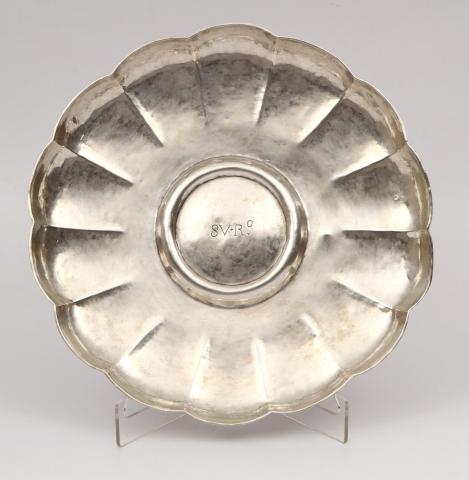Salva de Gomos
Salver
Silver, 17th / 18th century
Makers Mark AM (monogram), Santarém City Mark
Diam.: 27,5 cm
W.: 337,0 g
Prov.: J.M.J., Lisbon
Certificate of Authenticity: S. Ruival and H. Braga
Similiar piece in 'A Ourivesraia portuguesa e seus mestres', 2007, p.138
Prata Portuguesa, séc. XVII/XVIII
Marca de ensaiador de Santarém
Marca de ourives AM
Diâm.: 27,5 cm
Peso: 337,0 g
Prov.: J.M.J., Lisboa
Certificado de Autenticidade Sofia Ruival e Henrique Braga
Peça semelhante em 'A Ourivesraia portuguesa e seus mestres', 2007, p.138
Round, beaten silver sheet salver. Undecorated and of raised and scalloped edge, it is defined by fourteen concave and grooved centripetal sections encircling a plain reeded frame. The SVRº ownership mark is engraved to the plain central roundel.
To the dish underside, the stamped goldsmith mark MA (S30.0) and an assay-mark, datable to the late 17th or early 18th century, attributable to the cities of Santarém or Setúbal (S1.0). In addition to this salver, only six other objects have so far been recorded with identical maker’s mark, thus turning it into a rare example of silverware produced by a goldsmith’s from one of two possible Portuguese cities. The Museum of Evora, in the Southern Alentejo region, keeps in its collection a salver with identical assay mark.
Referring an equally shaped dish from the Ricardo Espírito Santo Silva Foundation, the Art Historian Leonor d’Orey stated: “a superb type of salver common in our 1600s silver production, made in plain beaten silver sheet, with no decoration, and raised and scalloped edge (…)” .
Salva redonda em prata portuguesa batida. Sem qualquer decoração, com orla levantada e recortada, definindo catorze gomos côncavos sulcados em dimanação do centro, apresenta uma moldura alteada lisa de perfil convexo. A marca de posse SVRº encontra-se gravada no centro do medalhão central liso.
Apresenta no seu reverso marca de ourives MA (S30.0) e de ensaiador atribuível a Santarém ou Setúbal (S1.0), datável entre finais do século XVII e inícios do XVIII . Só se conhecem, seis peças com esta marca de ourives, para além da aqui apresentada e constitui um raro exemplar de ourivesaria executada numa destas cidades. Com uma marca de ensaiador idêntica, mencionamos o exemplar da coleção do Museu de Évora .
Referindo-se a uma salva de formato idêntico existente na Fundação Ricardo Espírito Santo, Leonor d’Orey descreve: “…magnífico modelo de salva, tão comum na nossa prataria seiscentista, em prata batida lisa sem qualquer decoração, com o bordo levantado e recortado (…)” .?
- Arte Portuguesa e Europeia
- Pratas

